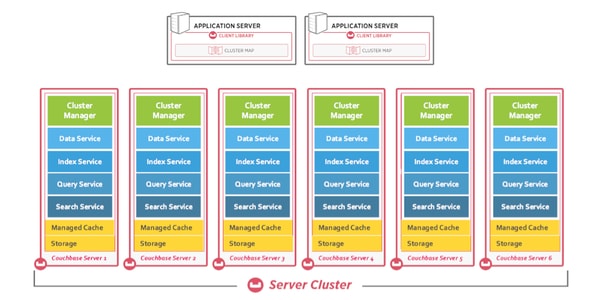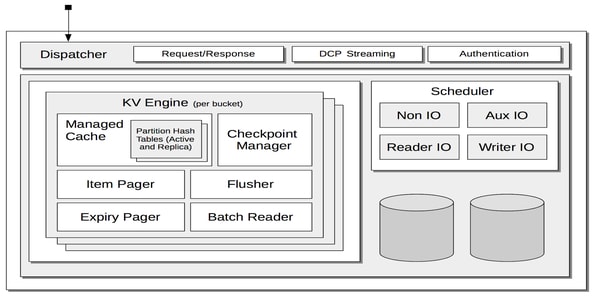Couchbase Interview Questions and Answers

Share This Post
Best Couchbase Interview Questions and Answers
Is that your next step is to attend the Couchbase interview? Do you wish to equip yourself with the right knowledge in order to succeed in your Couchbase interview at the very first attempt? If your answer is true for these two questions then you have reached the right place. In this blog, we have collected a group of frequently asked Couchbase Interview Questions and Answers suitable for both freshers and experienced candidates.
With an aim to provide you with the right stuff we have gathered all these top Couchbase interview questions and answers by taking the help of Couchbase industry experts. Preparing these questions will definitely help you with the right knowledge and builds confidence in you. All these questions are the best Couchbase interview questions and answers, according to our knowledge. Let’s get into the frequently asked Couchbase interview questions and answers.
Couchbase is actually known as Membase. It is a distributed, open-source, document-oriented, and multi-service NoSQL Database designed for business-critical applications. It delivers scalability, unparalleled performance, financial value, and unmatched versatility at scale across hybrid deployments and cloud. This server excels at supporting mission-critical applications while maintaining 99.99% availability and sub-millisecond latencies. Couchbase is the mixup of two prominent NoSQL technologies namely CouchDB and Membase.
Couchbase Server is a JSON document, distributed, and open-source database. It also runs on-devices and manages synchronization to the server. Couchbase is mainly used to provide low-latency data management for IoT applications, mobile, and large-scale web. The Couchbase is mainly designed for building interactive web applications. It also provides easy-to-scale key-value or JSON documents.
The main difference between Couchbase and MongoDB is as follows:
Couchbase | MongoDB |
Couchbase is an open-source document-oriented NoSQL database. This is the mixup of two technologies such as Membase and CouchDB. | MongoDB is the most popular document-oriented database program that uses JSON-like documents with schemas. |
N1QL querying language provides a powerful and expressive platform for querying, manipulating, and transforming JSON data | No declarative querying language is supported by MongoDB. The complex procedure is required for processing and querying data in applications |
Extended support for ANSI Joins will help the developers to use SQL effectively | Lack of effective document JOIN in MongoDB shared collection |
It extends standard SQL for JSON and queries JSON document models | MongoDB results in a high learning curve for SQL developers |
Couchbase Server is formally known as Membase. It is an open-source, distributed, document-oriented, and NoSQL database. It is optimized mainly for building interactive applications. In order to start Couchbase Server manually with the task manager, you need to follow some sequence of steps.
Step 1: In the Windows Task Manager, click on the Services tab to open the Service Management Console.
Step 2: In the Service Management Console, locate the Couchbase Server service and then right-click.
Step 3: Then at last select the start or stop option as appropriate.
Apache CouchDB is a document-oriented open-source NoSQL Database. It is developed by Apache Software Foundation and is implemented and written in Erlang, C++, JavaScript, and C. Apache CouchDB mainly allow you to access the data where you are in need of. CouchDB also allows you to run a single logical database server on a number of VMs or Servers. This database collects and stores data in the JSON document formats. Record Management can be achieved in a simplified way by using CouchDB across different computing devices because it makes use of schema-free data models.
Couchbase Buckets are mainly used to store data that can be flushed, created, deleted, and edited. Couchbase Server stores all the items in the buckets. The Couchbase bucket supports indexing, replication, data persistence, N1Ql queries, views, and caching. A count of 30 buckets can be created per cluster. Buckets allow you to replicate data automatically for high availability using Database Change Protocol (DCP). The Bucket types in Couchbase are as follows:
- Couchbase Buckets
- Memcached Buckets
- Ephemeral Buckets
In Couchbase Server, you can store multiple keyspaces in a single bucket. When you perform a scan, the query will make use of the index to fetch all the documents and get the document-keys and then at last apply the filter. The primary and secondary indexes in Couchbase can be created using the N1Ql query language. Basically, indexes increase the query efficiency on a bucket. The CREATE INDEX statement is used to create a secondary index.
Multiple TCP ports are used by Couchbase Server to facilitate the network communication between Couchbase clients, as well as with server components. Some various ports are used for cluster management. The TCP ports enable the Couchbase server to work correctly. The other ports are used by the Couchbase services and only opens on the required nodes where services are running.
Couchbase Cluster mainly contains one or more instances of Couchbase Server running on an independent node. In Couchbase, the new cluster is created by setting a cluster with an initial node of the Couchbase Server. Couchbase Cluster replicates data over Server instances to ensure high availability.
The key difference between Couchbase and CouchDB is as follows:
Couchbase | CouchDB |
Couchbase is actually known as Membase. It is a document-oriented, and multi-service NoSQL Database designed for business-critical applications. | Apache CouchDB is a document-oriented open-source NoSQL Database. It is implemented and written in Erlang, C++, JavaScript, and C. It is developed by Apache Software Foundation. |
Pessimistic locking is used by Couchbase | No lock is used by CouchDB because it only uses the concept of MVCC. |
N1QL is the own query language of Couchbase | CouchDB doesn’t have any query language. |
Couchbase supports flexible and robust development tools and environment | It is a rigid environment that runs on top of the OTP framework |
Couchbase ensures data consistency | CouchDB ensures fault tolerance and availability of data |
Looking for Best Couchbase Hands-On Training?
Get Couchbase Practical Assignments and Real time projects
Full-text Search in Couchbase will allow you to query, create, and manage specially purposed indexes defined on the JSON document present within a Couchbase bucket. It provides Google-like search capabilities on JSON documents. Extensive capabilities are provided by Full-text Search (FTS) for natural language querying. Full-text search is powered by open-source indexing and search library called Bleve. The Bleve is written and developed in the Go programming language. The full-text search uses Bleve mainly to perform indexing of documents. Lyzers and pre-built text are included in Full-text Search for various languages such as English, Hindi, Italian, Arabic, Persian, etc.
Couchbase is actually known as Membase. It is designed for the JSON document, distributed, and open-source database designed for business-critical applications. It also runs on-devices and manages synchronization to the server. The Core Architecture of Couchbase is designed and structured to simplify the process of building modern applications with a suitable data model to provide advanced security features, high availability, high performance, and high scalability. In order to gain an in-depth understanding of Couchbase architecture, you need to first understand the behavior of core run time capabilities and core components of the system.

The Couchbase Server consists of a single package installed on every node. The runtime systems included within the Couchbase Server are security architecture, replication architecture, storage architecture, caching layer architecture, and replication architecture. Couchbase components are specifically used to run independent workloads within the cluster. Core data services in Couchbase are used to perform CURD operations on all items present within buckets. Indexes are used to store multiple keyspaces in a single bucket. They also provide faster access to data present within buckets. In Couchbase, using SQL-like syntax you can query data with N1QL.
Basically, Cluster Manager in Couchbase runs on all the nodes of a cluster. The Cluster Manager coordinates cluster-wide operations and maintains essential pre-node processes. The architecture of the cluster manager mainly consists of two processes such as babysitter and ns-server. The babysitter is responsible for maintaining a wide variety of Couchbase Server Processes. Ns-server is mainly used to manage the node’s participation in the cluster.

Basically, the Couchbase Server contains one or more nodes, and each of which is a system running a single Couchbase Server instance. The node is a virtual or physical machine and its main aim is to host a single instance of Couchbase Server. The Couchbase Server is established on a node in four stages such as 1. Installed 2. Started 3. Initialized 4. Provisioned. The node can be a cluster of one server only when a variant of the fourth stage is achieved. You can add a node to the cluster after installation or during the installation.
N1QL is a query language and it is basically pronounced as nickel. It is popularly considered as Couchbase next-generation query language. The N1QL query language gives application developers a very powerful and expressive SQL dialect with standard ANSI for manipulating, transforming, and querying data present in the JSON document. It is formally a declarative query language that extends SQL for JSON. You can query your data via a native framework. The query service allows you to extract data sources from the Couchbase server by issuing queries. The queries can be issued by using the query service tools, REST API, or a Couchbase SDK.
The key functional blocks present in Couchbase are
- Data Manager
- Cluster Manager
Data Manager is a functional block that is mainly responsible for storing and extracting data useful for building applications.
The Cluster Manager coordinates cluster-wide operations and maintains essential pre-node processes. The architecture of the cluster manager mainly consists of two processes such as babysitter and ns-server.
Data Manager is a functional block that is mainly responsible for storing and extracting data useful for building applications. The data manager is a block of useful applications. Data Manager performs certain important and specific tasks without impacting the functionality of the software.
Storage Engine in Couchbase mainly stores data on disk by using Couchbase buckets. The storage engine mainly enables the Couchbase Server to hold a larger amount of data more efficiently than the size of memory.
The Data Service in the Couchbase server provides access to data. It also provides access to data on disk and in memory. The memory allocated for data service is configurable. The architecture of Data Service is shown below.

The principal components of Data Service Architecture are KV Engine, Dispatcher, Scheduler, Checkpoint Manager, etc.
The key features of Couchbase Server are as follows:
- Fastness: Couchbase Server is very fast and it facilitates the highest throughput and low latency.
- Reliable: It is enterprise-ready software and helps developers to build enterprise applications.
- Simple: This server is very simple in terms of expanding and managing servers.
Become Couchbase Certified Expert in 35 Hours
Get Couchbase Practical Assignments and Real time projects
Our Recent Blogs
Related Searches


3 thoughts on “Couchbase Interview Questions and Answers”
Valuable info. Fortunate me I discovered your site unintentionally, and I’m surprised why this twist of fate didn’t come about earlier!
I bookmarked it.
Very good article. I will be going through some of these issues as well.
Hello very nice web site!! Guy .. Excellent .. Superb ..
I will bookmark your web site and take the feeds also?
I’m satisfied to search out a lot of useful information here within the publish,
we need develop extra techniques on this regard, thanks
for sharing. . . . . .